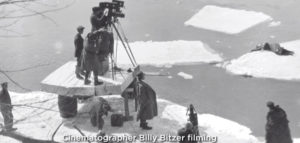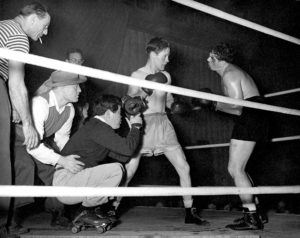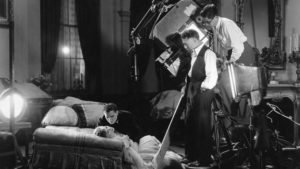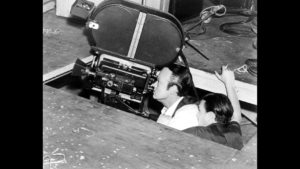 Created as part of the 100th anniversary celebration of The American Society of Cinematographers, Daniel Raim’s documentary, Image Makers: The Adventures of America’s Pioneer Cinematographers, examines said motion picture groundbreakers in the earliest years of filmmaking.
Created as part of the 100th anniversary celebration of The American Society of Cinematographers, Daniel Raim’s documentary, Image Makers: The Adventures of America’s Pioneer Cinematographers, examines said motion picture groundbreakers in the earliest years of filmmaking.
Critical to Raim’s endeavors was a partnership with Turner Classic Movies, specifically with senior vice-president of programming Charlie Tabesh. “He believed in myself and my team’s ability to make the film,” said Raim, producer-director-editor of Image Makers. “Any institution that spends as much time as they do preserving the past, there’s something very important and exciting about the attention that’s given to that. This was an opportunity for TCM audiences to observe and revisit movies that they love with new eyes.”
As the role of the cinematographer is largely an abstraction to the general moviegoing audience, Raim aimed to shed light on the craft, in addition to heralding the filmmakers at the forefront of motion picture photography. “I wanted to make a documentary that helps us appreciate the evolving art form of cinematography,” explained Raim, who had six months to make a 90-minute film, focusing on seven key craftspeople. “It was important that there be archival elements to construct a narrative and tell their story in the first person. Audiences make a personal human connection—suddenly it becomes more humanized. These were real people with real lives and families.”

To fortify his research, Raim mandated that he locate archival audio or print interviews related to his chosen seven artists, which he could use as primary references. “Not only did we find audio recordings, the ASC has an archive of audio recordings never before used,” Raim delineated, noting that cinematographer Kemp R. Niver had recorded aural histories with other DPs that had been stored in a box, unused since the 1970s. “You hear the cinematographers in their own words.”
One of the first cinematographers examined in Image Makers was Billy Bitzer, who had written an autobiography which provided Raim with a foundation. Working in the earliest silent films, Bitzer had photographed many of director D.W. Griffith’s most lauded films. Screenwriter Michael Sragow, also the project’s lead researcher, translated Bitzer’s memoirs into Image Maker’s overall initial structure, in addition to creating voice-over narration, eventually delivered by Michael McKean. “Take us on this journey from the beginning,” Raim communicated to Sragow.

With Martha Winterhalter as the documentary’s archival producer, the filmmakers also scoured The Academy of Motion Picture Arts and Sciences’ Margaret Herrick Library. “They were essential partners in providing this incredible, rich archive of stills,” Raim detailed, noting that The Academy’s film archivists facilitated Image Makers’s inclusion of home movies from the next major subject in the film—James Wong Howe. “His story is so rich and complex and fascinating.”
Added to The Academy’s generosity was the cooperation of The American Society of Cinematographers themselves. “The ASC opened the clubhouse doors to their camera museum and let us film their archives,” conveyed Raim of the legendary ASC facility. “Interviewees really responded to the physical environment of the clubhouse, to peek into that world. The archive, the clubhouse—we have tremendous gratitude for [the ASC] opening their doors and giving us opportunity.”
Sequentially, the next artisan featured in Image Makers was Roland ‘Rollie’ Totheroh, who had shot 36 iconic Charlie Chaplin feature films. “David Totheroh contributed to the film through narrating his grandfather’s journey,” Raim detailed. “He talked about how [Rollie] worked with Chaplin and invented the tools to realize Chaplin’s vision—and shoot physical comedy.”

Next in the film, combined in one section, was a dissemination of the work of cinematographers Charles Rosher and William Daniels. “They moved the art form forward by becoming cinematographers dedicated to [renowned movie stars] Mary Pickford and Greta Garbo,” said Raim, respectively. “We were delighted to have an opportunity to understand the creative process of lighting starlets: glamour lighting and the difference in the techniques in the 1920s, 1930s, and 1940s. The cinematographer’s creative input on framing and shot size was often just as important as the lighting. A long shot of Garbo walking could express as much emotion and power as a close-up. They developed close relationships: the star and the cinematographers.”
Highlighted after Rosher and Daniels was Karl Struss, who began in cinema as a still photographer in the 1910s. “He brought his photographs to [director] Cecil B. DeMille, who hired him to do set stills,” Raim expressed. “He graduated into cinematography, including Sunrise, the grand masterwork of all silent films; film grammar reached it peak with Sunrise. This was the first American film from German silent film director F.W. Murnau. Struss freed the camera—the roving camera, the unchained camera—marrying the inventiveness and artistry of Hollywood cinematography with German expressionist cinematography.”

Finally, the last cinematographer explored in Image Makers was Gregg Toland, most noted for shooting the 1941 Orson Welles classic, Citizen Kane. “We were really fortunate that Toland’s daughter was alive and well,” said Raim of the fresh perspective she offered. “We interviewed her next to the Mitchell camera that [Gregg Toland] used to shoot Citizen Kane. That would become an important moment in the film. He died at age 44—sitting next to the camera, she touched the camera and said, ‘I could almost feel my father being here,’ reviving the spirit of people who are no longer with us—who they are as people.”
Ultimately, Raim hoped that his film illuminates the craft of cinematography for professionals and cineastes alike. “Film is the most collaborative art form,” he stated. “It’s the cinematographer’s job to visualize the movie and interpret what’s in the director’s mind visually. The cinematographer brings their own ideas of the world into the visual design of the film that artistically interprets the emotional, dramatic and psychological needs of the screenplay. They invented the language of film before the directors became the auteur of the film.”
To view Image Makers, please link to http://www.tcm.com/watchtcm/movies/2196145/Image-Makers-The-Adventures-of-America-s-Pioneer-Cinematographers/.





